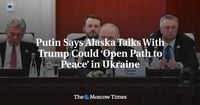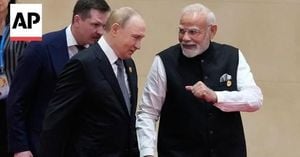In a week dominated by high-stakes diplomacy and tense international maneuvering, Russian President Vladimir Putin announced that "understandings" had been reached with U.S. President Donald Trump during their recent Alaska summit, potentially opening a new chapter in efforts to resolve the war in Ukraine. Speaking at the Shanghai Cooperation Organisation (SCO) summit in Tianjin, China, on September 1, 2025, Putin’s remarks signaled cautious optimism, though the path to peace remains fraught with uncertainty and competing narratives.
Putin’s declaration came just weeks after his nearly three-hour meeting with Trump in Alaska, a session that both leaders later described as constructive, if not yet conclusive. According to The Indian Express, Putin told the plenary session, “The understandings reached at the recent Russia–U.S. meeting in Alaska, I hope, also contribute toward this goal,” referring to the resolution of the Ukrainian crisis. He added that these discussions would be shared in greater detail with fellow SCO leaders, including Chinese President Xi Jinping and Indian Prime Minister Narendra Modi, during bilateral meetings on the summit’s sidelines.
While Putin stopped short of specifying what those “understandings” entailed, the diplomatic dance around Ukraine’s future has intensified. U.S. special envoy Steve Witkoff, speaking to CNN, claimed that Putin had agreed to security guarantees for Ukraine as part of a potential peace deal, though Moscow has yet to publicly confirm this. Witkoff elaborated that the U.S. and Europe were prepared to offer Ukraine "Article 5-like language"—a reference to NATO’s collective defense clause—though without extending NATO membership itself. Trump, for his part, insisted after the Alaska summit that “we’re not there yet” on a final deal, but described the talks as “extremely productive.”
Putin’s public comments at the SCO summit, reported by BBC and Hindustan Times, reiterated long-standing Russian grievances and justifications. He placed the blame for the conflict squarely on Western shoulders, stating, “Attempts by the West to drag Ukraine into NATO are one of the causes; it did not arise as a result of ‘invasion,’ but as a result of a coup d’état in Kyiv, supported by Ukraine’s Western allies.” This narrative has been consistently countered by Western governments, who point to Russia’s 2014 seizure of Crimea and the full-scale invasion of Ukraine in February 2022 as the real triggers for the ongoing war.
Nonetheless, Putin emphasized that Russia remains committed to the principle that no country can ensure its security at the expense of another, and that “UN principles, including respect for the sovereignty of states, are still valid and unshakable today.” He called for addressing the root causes of the crisis and establishing a “security balance.”
China and India, both major buyers of Russian oil and key players in the region, received special mention from Putin for their “efforts and proposals aimed at facilitating the resolution” of the Ukraine crisis. As BBC noted, their support has attracted criticism from Western capitals, who argue that such trade props up the Russian economy and undermines sanctions intended to constrain Moscow’s war effort. Nevertheless, Putin expressed gratitude to Xi Jinping and Narendra Modi, underscoring the importance of their diplomatic engagement. The SCO summit itself became a stage for these leaders to demonstrate unity, with Modi and Putin even sharing a warm hug before the formal proceedings began.
Yet, for all the talk of progress, the situation on the ground remains perilous. Just days before Putin’s remarks, Russia launched its second-largest aerial attack on Ukraine since the war began, firing 629 drones and missiles at Kyiv and killing 23 people. The scale of the assault drew condemnation from European leaders and renewed calls for a durable peace. French President Emmanuel Macron, in particular, said that Putin faced a Monday deadline—set by Trump—to agree to peace talks with Ukrainian President Volodymyr Zelensky. If Putin failed to respond, Macron warned, it would show “again President Putin has played President Trump.”
Trump himself, speaking to CNN on August 22, stated he had given Putin “a couple of weeks” to respond before the U.S. would consider further action. He has repeatedly claimed he could resolve the Ukraine war in a single day, though his actual proposals have shifted over time. After the Alaska meeting, Trump dropped his previous demand for an immediate ceasefire and instead called for a permanent peace deal. He also met with Zelensky and top European leaders in Washington, where he insisted there would be “no going into NATO by Ukraine” as part of any agreement, but hinted at robust security guarantees nonetheless. “We’ll give them good protection,” Trump said, clarifying that this would not involve sending U.S. troops to Ukraine.
For his part, Ukrainian President Volodymyr Zelensky has remained wary of any deal that might compromise Ukraine’s sovereignty or security. He has rejected proposals for a buffer zone with Russia, accusing Moscow of not being ready for genuine diplomacy and merely seeking to postpone the war’s end. “We expect a framework for security guarantees to be set out on paper as soon as this week,” Zelensky said, signaling both impatience and skepticism about Russia’s intentions.
Meanwhile, Russian officials have criticized Western proposals as “one-sided and clearly designed to contain Russia,” claiming they turn Kyiv into a “strategic provocateur.” The back-and-forth has only heightened the sense that, despite diplomatic overtures and headline-grabbing summits, a comprehensive peace remains elusive.
Still, the Alaska summit and subsequent SCO discussions mark a notable shift in the diplomatic landscape. The involvement of China and India—two countries with significant leverage over Moscow—adds a new dimension to the search for a solution. As Hindustan Times observed, Putin’s willingness to share details of his talks with Trump with other world leaders suggests a broader effort to build consensus, or at least to project an image of openness to negotiation.
Whether these “understandings” will translate into concrete steps toward ending the war is an open question. The coming weeks, shaped by deadlines, high-level meetings, and the ever-present risk of escalation, will test the resolve and sincerity of all parties involved. For now, the world watches and waits, hoping that the tentative progress made in Alaska and Tianjin can be transformed into lasting peace for Ukraine.





